Canna leaf roller refers to two different Lepidoptera species that are pests of cultivated cannas. Caterpillars of the Brazilian skipper butterfly, also known as the larger canna leaf roller, cut the leaves and roll them over to live inside while pupating and eating the leaf. In addition, caterpillars of the lesser canna leaf roller, a grass moth, will sew the leaves shut before they can unfurl by spinning a silk thread around the leaf. The resultant leaf damage can be distressing to a gardener.

Panoquina ocola, the ocola skipper or long-winged skipper, is a species of butterfly of the family Hesperiidae. It is found in Paraguay north through tropical America and the West Indies to south Texas, and strays occur north to southeast Arizona, Kansas, Illinois, Michigan, southern Ontario, and New York.

Calpodes is a genus of skipper butterflies in the family Hesperiidae.

Burnsius albezens, the white checkered-skipper, formerly known as Burnsius albescens and Pyrgus albescens, is a species of skipper. It is found at low altitudes in the southern United States and Mexico. It is a rare stray to southwest Utah and central Texas and is found in a variety of dry, open habitats.

Burnsius oileus, the tropical checkered skipper, is a species of skipper. It is found in the United States, south through the West Indies, Mexico and Central America to Costa Rica. It was transferred to genus Burnsius in 2019, and was previously known as Pyrgus oileus.

Amblyscirtes hegon, the pepper-and-salt skipper, is a butterfly of the family Hesperiidae. It is found from Nova Scotia and Maine, west to southern Manitoba, south to Georgia, northern Florida and south-eastern Texas. It is mostly absent from the coastal plain.

Amblyscirtes vialis is a butterfly of the family Hesperiidae. It is found from British Columbia east across southern Canada to Maine and Nova Scotia, south to central California, northern New Mexico, Texas, the Gulf states and northern Florida.
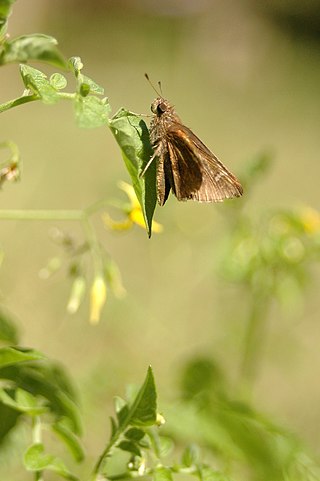
Lerema accius, the clouded skipper, is a butterfly of the family Hesperiidae. It is found in the United States from Georgia west to Texas, south to Florida, and south through Mexico and Central America to Venezuela and Colombia.

Lerodea eufala, the Eufala skipper or rice leaffolder, is a species of butterfly in the family Hesperiidae. It is found from the coast of Georgia, south through Florida and west across the southern United States to southern California, south through Mexico and Central America to Patagonia. In the summer, it expands its range north to central California, North Dakota, southern Wisconsin, northern Michigan and Washington, D.C.

Anthanassa frisia, the Cuban crescentspot, Cuban checkerspot or Cuban crescent, is a butterfly of the family Nymphalidae. Subspecies tulcis is known by the common names pale-banded crescent or Tulcis crescent; it is treated as a species by some authors.

Wallengrenia otho, the southern broken dash or broken dash skipper, is a butterfly of the family Hesperiidae. It was originally described by Smith in 1797. It is found from eastern Texas and the southeastern United States, south through the West Indies and Central America to Argentina. Strays can be found as far north as central Missouri, northern Kentucky and Delaware.
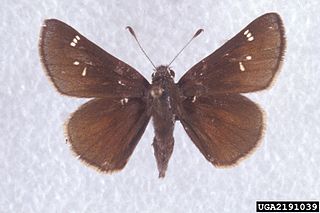
Atrytonopsis hianna, the dusted skipper, is a butterfly of the family Hesperiidae. It is found in the United States from eastern Wyoming, central Colorado, northern New Mexico and central Texas east to New Hampshire and Massachusetts, south to peninsular Florida and the Gulf Coast.

Cecropterus dorantes, the lilac-banded longtail or Dorantes longtail, is a species of butterfly in the family Hesperiidae. It is found from Argentina, north through Central America, Mexico, and the West Indies to southern Texas and peninsular Florida. Strays can be found as far north as northern California, southern Arizona, southern Missouri and North Carolina.
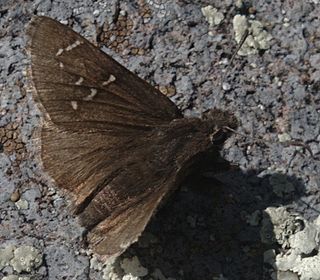
Thorybes mexicana, the Mexican cloudywing, mountain cloudy wing or Nevada cloudy wing, is a butterfly of the family Hesperiidae. It is found in the high elevation mountains of the western United States south into Mexico.
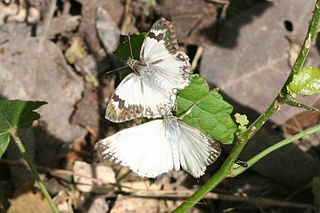
Heliopetes macaira, the Turk's-cap white-skipper , is a butterfly of the family Hesperiidae. It is found from southern Texas in North America, south through Central America to Paraguay.

Celotes nessus, the common streaky-skipper, is a butterfly of the family Hesperiidae. It is found in North America from southern Arizona, southern New Mexico, and western Texas south to northern Mexico. Rare strays can be found up to southern Oklahoma and northern Louisiana.
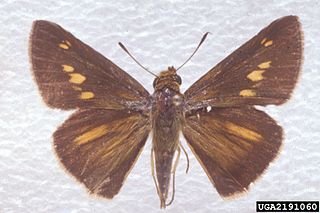
Euphyes dion, the Dion skipper or Alabama skipper, is a species of butterfly of the family Hesperiidae. It is found in scattered populations along the Atlantic coast of North America, from western Massachusetts and south-eastern New York south to north-eastern Florida, west to north-eastern Texas, and north to south-eastern North Dakota, northern Wisconsin, southern Ontario and southern Quebec. It is listed as a species of special concern in the US state of Connecticut.
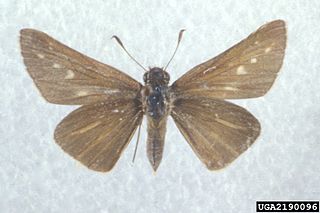
Panoquina panoquin, the salt marsh skipper, is a butterfly of the family Hesperiidae. It is found along the Atlantic Coast of the United States, from New York south to Florida and the Florida Keys, west along the Gulf Coast to southern Texas.

Anthanassa texana, the Texan crescentspot, is a species of butterfly in the family Nymphalidae. It is found from Guatemala north through Mexico to southern California, east across the southern United States to northern Florida, Georgia and South Carolina. Strays may be found up to Arkansas, Missouri, Illinois, South Dakota, and central Nevada. The habitat consists of deserts, dry gulches, open areas, streamsides, road edges, and city parks.




















